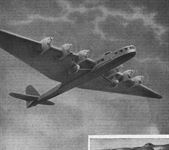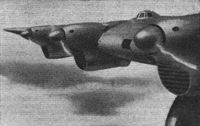
Гигантские самолеты Туполева
<...>
Огромный пассажирский моноплан АНТ-20 "Максим Горький" спроектировали и построили как флагман агитэскадрильи "Максим Горький", сформированной к 40-летию творческой деятельности писателя Максима Горького. Самолет строился на добровольные пожертвования населения СССР (было собрано примерно шесть миллионов рублей). Проектирование и постройку машины выполнили в очень сжатые сроки.
АНТ-20 проектировался на основе АНТ-16, но был больше своего предшественника. На момент постройки АНТ-20 являлся самым большим самолетом в мире. В отличие от многих самолетов-гигантов "Максим Горький" полностью соответствовал предназначению и очень неплохо летал. Первый полет АНТ-20 выполнил в Москве 17 июня 1934 года под управлением экипажа во главе с М. М. Громовым. 18 августа того же года самолет передали агитэскадрилье "Максим Горький".
Силовая установка состояла из восьми моторов АМ-34ФРН мощностью по 900 л. с.; шесть двигателей установили в крыле и два над фюзеляжем. Размах крыла составлял 63,00 м, максимальная взлетная масса - 42 000 кг, максимальная скорость - 245 км/ч.
"Максим Горький" разбился на публичном показе 1935 года - в него врезался истребитель, который попытался описать петлю Нестерова вокруг крыла АНТ-20. Катастрофа поставила крест на планах постройки еще 16 гигантов, изготовили только один АНТ-20бис, известный также как ПС-124 и Л-760 (по гражданской регистрации). Первый полет АНТ-20бис выполнил в конце 1929 года.
От первого АНТ-20 вариант "бис" отличался новыми крылом, фюзеляжем и хвостовым оперением. Силовая установка состояла из шести моторов АМ-34ФРНВ мощностью по 1200 л. с., установленных в крыле. Карьера АНТ-20бис завершилась после аварийной посадки 14 декабря 1942 года.
<...>
Описание:
- Гигантские самолеты Туполева
- Flight, August 1934
THE "MAXIM GORKY” - Flight, December 1940
RUSSIAN AIRLINER L-760
Фотографии
-
Мировая Авиация 246
Экипаж гигантского АНТ-20 "Максим Горький" состоял из 20 человек, на борту имелись типография, кинозал, кинолаборатория и ряд другого уникального для того времени оборудования. Первый полет АНТ-20 выполнил 17 июня 1934 года, но 18 мая 1935 года в крыло "Максима Горького" врезался истребитель И-5, АНТ-20 разбился.
-
Авиация и Космонавтика 2007-10 / И.Шевчук - 85 лет конструкторскому бюро ОАО "Туполев"
АНТ-20 "Максим Горький" перед своим первым полетом
-
Авиация и Космонавтика 2025-02 / ??? - Время Микулина
Микулинские моторы М-34ФРН поднимали в воздух самолет-гигант АНТ-20 «Максим Горький»
-
Aeroplane Monthly 1990-08 / J.Stroud - Wings of Peace
Самый большой советский самолет 30-х годов - АНТ-20 "Максим Горький" имел восемь моторов М-34Р
The ANT-20 Maksim Gorkii photographed in August 1934. There are four PS-9s in the background.Другие самолёты на фотографии: Туполев АНТ-9 / ПС-9 - Россия - 1929
-
Aeroplane Monthly 1990-08 / J.Stroud - Wings of Peace
The figures in the picture emphasize the size of the ANT-20 Maksim Gorkii.
-
Мировая Авиация 64
18 мая 1935г.: произошла самая крупная катастрофа того времени с участием летательного аппарата тяжелее воздуха. Советский АНТ-20 "Максим Горький" разбился в результате столкновения с другим самолетом в небе над Тушино. С самолетом погибло 56 человек, находившихся на его борту.
-
Авиация и Космонавтика 2014-06 / Знаменательные даты июня в истории авиации
Восьмимоторный самолет-гигант АНТ-20 "Максим Горький"
-
Авиация и Космонавтика 1998-09 / А.Демин - Праздники в небесах (2)
Лидер нескольких воздушных парадов АНТ-20 "Максим Горький"
-
Авиация и Космонавтика 2022-10 / ??? - 100 лет конструкторскому бюро А.Н. Туполева
Самолет-гигант АНТ-20 «Максим Горький»
-
Авиация и Космонавтика 2002-08 / В.Михайлов - Щит и меч неба отчизны
Самолет-гигант "Максим Горький" над Красной площадью, апрель 1935г.
-
Jane's All the World Aircraft 1980 / Encyclopedia of Aviation - Aircraft A-Z - v5
Tupolev ANT-20 Maxim Gorki.
-
Авиация и Космонавтика 1997-11 / В.Ригмант - Под знаками "АНТ" и "ТУ" (2)
АНТ-20 "Максим Горький"
-
Авиация и Космонавтика 2011-03 / В.Котельников - Пассажирский самолет ПС-124
ПС-124 на аэродроме в Казани
-
Авиация и Космонавтика 2011-03 / В.Котельников - Пассажирский самолет ПС-124
ПС-124 на аэродроме в Казани
-
Aeroplane Monthly 1990-08 / J.Stroud - Wings of Peace
Регистрационный номер: СССР-Л760 [8] The ANT-20bis (PS-124) SSSR- L760.
-
Авиация и Космонавтика 2019-05 / Некоторые знаменательные даты мая в истории авиации
Регистрационный номер: СССР-Л760 [8] -
АвиаМастер 2004-06 / В.Котельников - Эпоха гигантов /Монография/
Регистрационный номер: СССР-Л760 [8] Второй экземпляр "Максима Горького" - АНТ-20бис (ПС-124) был построен только в 1939 году без тандемной установки двигателей над фюзеляжем.
АНТ-20бис мог перевозить до 64 пассажиров при экипаже из девяти человек. Несколько более тяжелый, чем АНТ-20, АНТ-20бис развивал максимальную скорость 275 км/ч. -
Авиация и Космонавтика 2011-03 / В.Котельников - Пассажирский самолет ПС-124
Регистрационный номер: СССР-Л760 [8] ПС-124 на аэродроме
-
Авиация и Космонавтика 2011-03 / В.Котельников - Пассажирский самолет ПС-124
Регистрационный номер: СССР-Л760 [8] Командир корабля Н.И. Новиков и второй пилот Р.С. Боканев, 1940 г.
-
Авиация и Космонавтика 2019-06 / Некоторые знаменательные даты июня в истории авиации
Регистрационный номер: СССР-Л760 [8] -
Aeroplane Monthly 1990-08 / J.Stroud - Wings of Peace
This view of the ANT-20bis, in company with two fighters, shows off the aircraft's vast wing area.
-
Aeroplane Monthly 1990-08 / J.Stroud - Wings of Peace
View from the ANT-20bis showing the starboard engine installation, mainwheel spat and engineer’s position.
-
Авиация и Космонавтика 2011-03 / В.Котельников - Пассажирский самолет ПС-124
Сборка ПС-124 в цехе завода № 124
-
Авиация и Космонавтика 2011-03 / В.Котельников - Пассажирский самолет ПС-124
Собранный ПС-124 в цехе в Казани
-
Flight 1934-11 / Flight
The stand arranged by the Russian Soviet. In the foreground is a full-sized model of the balloon gondola used for stratosphere flights. Behind it is the ancient ski-plane used for the Chelyuskin expedition rescue. On the left is a pair of the huge double wheels of the Maxim Gorky undercarriage, a model of which may be seen above the emblematic hammer and sickle near the foreground.
Другие самолёты на фотографии: Поликарпов Р-5 - Россия - 1928
-
Авиация и Космонавтика 2011-03 / В.Котельников - Пассажирский самолет ПС-124
Тележка шасси ПС-124 до установки обтекателя
-
Авиация и Космонавтика 2011-03 / В.Котельников - Пассажирский самолет ПС-124
Тележка шасси после установки обтекателя
-
Авиация и Космонавтика 2011-03 / В.Котельников - Пассажирский самолет ПС-124
Хвостовое оперение ПС-124
-
Авиация и Космонавтика 2011-03 / В.Котельников - Пассажирский самолет ПС-124
Регистрационный номер: СССР-Л760 [8] Перед перегонкой из Казани в Москву на киль нанесли эмблему с надписью "ПС-124"
-
Авиация и Космонавтика 2011-03 / В.Котельников - Пассажирский самолет ПС-124
Фонарь кабины левого механика
-
Авиация и Космонавтика 2011-03 / В.Котельников - Пассажирский самолет ПС-124
Внутри задней части крыла
-
Авиация и Космонавтика 2011-03 / В.Котельников - Пассажирский самолет ПС-124
Так выглядела задняя часть фюзеляжа изнутри
-
Авиация и Космонавтика 2011-03 / В.Котельников - Пассажирский самолет ПС-124
Мотор М-34ФРНВ на самолете ПС-124 (вид изнутри крыла), август 1939г.
-
Авиация и Космонавтика 2011-03 / В.Котельников - Пассажирский самолет ПС-124
Дверца, ведущая изнутри крыла к мотору
-
Авиация и Космонавтика 2011-03 / В.Котельников - Пассажирский самолет ПС-124
Дверь в хвостовом коке самолета
-
Авиация и Космонавтика 2011-03 / В.Котельников - Пассажирский самолет ПС-124
Входной трап в выпущенном положении
-
Авиация и Космонавтика 2010-11 / М.Никольский - Государственный Летно-испытательный Центр
М.М. Громов в кабине самолета "Максим Горький"
-
Авиация и Космонавтика 1998-09 / А.Демин - Праздники в небесах (2)
А.Я.Алкснис и М.М.Громов в кабине АНТ-20 "Максим Горький"
-
Авиация и Космонавтика 2011-03 / В.Котельников - Пассажирский самолет ПС-124
Место командира корабля
-
Авиация и Космонавтика 2011-03 / В.Котельников - Пассажирский самолет ПС-124
Первый пассажирский салон и место штурмана
-
Авиация и Космонавтика 2011-03 / В.Котельников - Пассажирский самолет ПС-124
Второй пассажирский салон
-
Авиация и Космонавтика 2011-03 / В.Котельников - Пассажирский самолет ПС-124
Третий пассажирский салон
-
Flight 1935-07 / Flight
SYMBOLICAL. Members of the Soviet Aero-hydrodynamical institute who took part in a recent sportsmen's parade in Moscow carried giant models of the machines which are to replace the Maxim Gorki.
-
Aeroplane Monthly 1990-08 / J.Stroud - Wings of Peace
Регистрационный номер: СССР-Л760 [8] KEITH WOODCOCK'S painting shows the ANT-20bis (PS-124) SSSR-L760 which operated some Aeroflot services.
-
Flight 1940-12 / Flight
The Soviet L-760 is a big airliner, so big that it has sleeping cabins in the wings for some of its 64 passengers.
-
Flight 1940-12 / Flight
The small "look-out" on the top surface is part of the wing compartment.
-
Авиация и Космонавтика 2011-03 / В.Котельников - Пассажирский самолет ПС-124
Компоновка самолета АНТ-20бис
-
Авиация и Космонавтика 2011-03 / В.Котельников - Пассажирский самолет ПС-124
Размещение пассажирских кабин на ПС-124
-
АвиаМастер 2004-06 / В.Котельников - Эпоха гигантов /Монография/
АНТ-20 проект военного варианта.
- Фотографии






















































